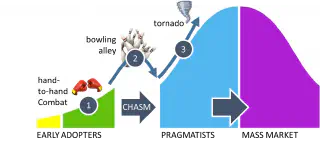
Does your product sell like hot cakes? In that case, you can skip to the next post. Yet if your startup sells or aims to sell disruptive technology, you are bound to have a missionary or (even worse) evangelical sales process.
Selling disruptive technology is a vastly different play from selling an improvement or extra feature to an existing product category. But how do you know your technology or product is so disruptive?
Here are some of the typical symptoms:
Ok, so you are defining a new product category. That means you need to get the word out that your product is the best thing since sliced bread, and get them hooked on your dope.
This type of sales process boils down into missionary and/or evangelical sales. Missionary is the least involved of the two. Your religion is already known to the masses. You just need to convince them that it’s wise to convert. Evangelical sales is progressively more difficult. You first need to tell them about your religion, and why they need a religion in the first place. Only then comes the missionary part of explaining why they should convert to your religion.
What does this really mean for your startup and your chances in the market?
With missionary sales, your prospects know the need and potential business benefit, but they haven’t seen the solution in action. Or worse, they believe the solution does not apply to them or is too cumbersome to adopt.
Here’s the missionary sales approach:
The risk is that you educate the customer on the benefits of competing solutions. But as you have brought the value proposition to the customer, if your solution works, you often get the benefit of bypassing their competitive analysis in the first sale. The take away is to know how you differentiate and be ready to prove the added value over competition.

The close integration and contact with the customer means a heavy involvement of field application engineers (FAEs), sales, and support. Your business scales only as fast as you can scale these people. Hence it is vital to get out of this mode as fast as possible. The high-touch sales is needed to cross the chasm and win the first niche markets. Once you win a number of related niches, your product may take off. To make sure this not only will happen, but also can happen, you need to design your offering for scalability from the get go. That often means you need to have a different business and deployment model ready for when the market is ready to fly. Can you bring down the complexity to sell your product online? Can you move from a corporate business model to a pay-as-you-go model?
So how do you get through this process and out of the missionary position (pun intended)?
What about evangelical sales? Customers don’t know they have a need. They are happy with the status quo. I’ve seen automotive companies writing all code by hand in assembly while there was a good C-compiler available. Why? That’s how they always did it. Never change a winning team.
Interestingly if you are the one to give the prospect the insight into their latent need, you have their trust and become the preferred supplier on their list of potential solutions.
Here’s the evangelical sales approach:
Note that step 1 and 2 are all about the “problem-solution fit”. Is there a problem that is worth solving? Steps 3 through 5 are about the “product-market fit”. Is there an actual product that can deliver the benefits?
Evangelical sales is always missionary.
How do you get through an evangelical sales process as a startup?
Tim Ferris’ adage holds here:
big ideas have more likelihood of success than small ones.
For large corporations it is easier to invest in a business promise than in a small advantage.
Evangelism often requires 10 years to get the product in the market, and then 10 years to grow to the market leader. The market potential has to be huge to warrant this. Such a long time frame requires investors with deep pockets and patient capital. Qualify your investors on this ability to avoid spending all your time raising too little too often. Also here it is usually better to think big than to think small, as it is easier to get funding for big ideas.
If you have a missionary sales process, that needs convincing to show investors you can scale fast enough. Faster than you can add FAEs and sales people. Know how to scale up when the product category takes off. You need to plan your go-to-market extremely carefully to scale as fast as possible. Consider growth hacks and carefully select sales partners that can leverage their existing network. Here, the biggest risk is you one-day wake up and discover your once-promising technology startup has become a service shop.
How do you win souls for your technological heaven?

About Martijn Rutten
Fractional CTO & technology entrepreneur with a long history in challenging software projects. CTO at LUMO Labs impact VC. Former CTO of scale-up Insify, changing the insurance space for SMEs. Former CTO of fintech scale-up Othera, deep in the world of securitized digital assets. Coached many tech startups and corporate innovation teams at HighTechXL. Co-founded Vector Fabrics on parallelization of embedded software. PhD in hardware/software co-design at Philips Research & NXP Semiconductors. More about me.
Related Posts